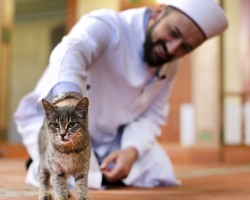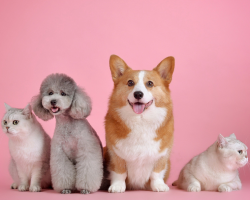If the cat has a stomach, paws or withers, then this may indicate a pathology. Only a veterinarian will be able to find out the true reason, in more detail in the article.
Content
- Why did the cat have a stomach and hind legs: Reasons
- Video: The cat or cat has wool - the causes and methods of treatment
- Pathological reasons for the loss of wool in cats: what's the matter?
- Video: A cat bald during estrus - what are the reasons?
- How to diagnose a house and in a veterinary clinic if a cat has a bald spot?
- The cat has a stomach and hind legs, withers: what to do, what to treat?
- Prevention so that the cat does not bald
- Video: Why does the cat have wool, falling wool in cats
- Video: the cat itches, but there is no flea, it constantly loses
- Video: Catching in a cat
The process of hair loss of both humans and animals is called alopecia. The loss of wool in a cat may be accompanied by dermatitis and wounds, but it can also take place asymptomatic. First you need to determine the cause of alopecia.
Read on our website another interesting article on the topic: "Home cat behavior". You will learn how to understand what the cat wants to tell you.
From this article you will learn why it happens that cats are bald. You will also know how to diagnose and how to treat an animal with similar problems. Read further.
Why did the cat have a stomach and hind legs: Reasons

Any process of hair change in a cat are called molting. It can be physiological or pathological. Wool on the back of the cat is always thicker than on the stomach. Therefore, with the loss of the hairline, the stomach will first be exposed. The cat adapts to life in a house or apartment. Usually seasonal molting, like wild cats does not occur, the wool changes gradually.
So, why did the cat have a stomach and hind legs? The intensity of wool loss can increase for the following reasons:
- Juvenile molting. Can be observed in kittens older than 5 months. It lasts 3 months. Children's wool is replaced by a new one.
- Pregnancy and lactation. During the production of hormones, the wool on the stomach falls. Since newborn kittens suffer from a lack of heat, it is necessary that the mother warm them with a bare belly. And for feeding, it is also desirable that there is no wool around.
- Old age. The condition of the body of elderly animals changes at the hormonal level. Chronic diseases appear, which often lead to the disappearance of the woolen cover.
Standard molting is not a serious problem. This is a normal phenomenon, especially if it is seasonal (spring or autumn). The cat simply changes in appearance to a change in temperature. However, if the molting is accompanied by a deterioration in the health of the cat, a decrease in its activity and health problems appear, you need to contact the veterinarian.
Video: The cat or cat has wool - the causes and methods of treatment
Pathological reasons for the loss of wool in cats: what's the matter?

The cause of the pathological loss of wool on the stomach can be a number of factors. What is the matter in this case? Here are the pathological reasons for the loss of wool in cats:
- Unstable nutrition
If you choose the food of the economy class or ordinary products, the cat may not have enough “building material” to form wool. The reason is not only a lack of vitamins, but also in their overdose.
- Vlavoedy
These are parasites that feed on wool.
- Helminths
Worms, worms that secrete endotoxins. The latter affect the hair bulbs, and also do not allow vitamins in the gastrointestinal tract to absorb the body. The signs of worms include diarrhea, vomiting, rejection of food, etc.
- Stress
Moving, exhibitions, fright and the appearance of a new animal in an apartment or house, in the body of a cat often cause wool discharge.
- Physical factors
If the house is hot, and the humidity level is insufficient, malfunctions occur in the thermoregulation of the animal. It is saved from overheating, dropping excess "clothes".
- Chemical factors
With frequent bathing, the wool can also fall, since detergents destroy the sewn -in hair shell.
- Hormonal malfunctions
Their causes are malfunctions of the thyroid gland, adrenal glands and uncontrolled use of steroid drugs.
- Chronic intoxication
It appears if the pet consumes food affected by the fungus or containing toxic substances. The poison is excreted from the body not only through diarrhea and vomiting, but also with wool.
- Allergy
An allergy can be to separate components in the stern, household chemistry, cosmetics, means from parasites and wool of other animals. The cat reads it, it licks the places where it has a rash and itching. Due to zealous lizaniya, wools can disappear.
- Fleas
Parasites often change the behavior of a pet - the cat begins to itch sharply. Itching can bother the cat even at night. The animal baches entire shreds of wool, and the places that it scratches are covered with crusts. Wounds are often accompanied by infections (pus forms). With a large -scale flea population, the general condition of the cat deteriorates - it is losing weight, becomes restless and angry. Even people can suffer from fleas - parasites bite their legs.
- Ticks
During damage to the pet with ticks, bald spots on the muzzle (in the ears) and on the front paws may appear. Bolding is located symmetrically. It is accompanied by severe itching. The wounds are often caught up. The skin of the cats is microscopic and appears in those who suffer from weak immunity. Sites of bare skin blush and are covered with dry scales.
- Lichen
This fungus is dangerous for humans. Lichei is round foci with chopped hair. The skin turns red, covered with scales, and the cat constantly scratches the affected places. Over time, the lesion focus increases.
- Adenitis
It is an inflammation of the sebaceous glands. Usually caused by a genetic predisposition. Adenit most often affects kittens and elderly animals. The propharyns are round. They are formed in the ears, neck and head. The disease is accompanied by an unpleasant odor. The skin becomes yellow or gray, as well as sticky. Do not confuse adenitis and eczema.
- Folliculite
An infection that affects the hair follicles. It causes brittle hair. Inflamed bubbles are formed on the muzzle and neck. The cat suffers from itching. The reason is allergies or weak immunity.
- Nesting alopecia
There are two types:
- Autoimmune - It is a periodic appearance of bald places. The wool is gradually restored. The cat does not suffer from itching.
- Symmetric - When baldness appears in the groin, on the stomach and hips. It is much less common.
If such symptoms appear, you need to contact the veterinarian with the cat for advice.
- Seborrhea
It is congenital and acquired. The affected places are covered with small scales. A dandruff appears on the wool of the pet, an unpleasant odor comes from it.
- Hypothyroidism
Genetic pathology can cause a complete loss of wool in childhood. In newborn kittens of woolen cover, rare. AT 3-4 months Kittens are completely bald. Be careful, because without wool the kitten can freeze in winter or overheat in the summer. Pay attention to the cat’s drinking mode in the summer and provide it with warming in winter.
- Hyperthyroidism
Dot in the thyroid gland and an increased amount of hormones leads to seborrhea. The cat constantly licks itself, and with simple stroking, its wool will easily fall out. Any hormonal violation can cause such a reaction:
- Adrenal diseases
- Drages in the pancreas
- Ovarian problems or testes
The usual taking hormonal drugs also often cause a strong production of hormones. The cat drinks a lot of water, often goes to the toilet, and its abdominal cavity increases in size.
- Oncological diseases
When the tumor is formed, the hair completely falls out at the bottom of the body. Gradually, bald spots spread to the chest and paws. At the end of the disease, the cat loses most of the hairline.
Video: A cat bald during estrus - what are the reasons?
How to diagnose a house and in a veterinary clinic if a cat has a bald spot?

Since there are a lot of causes, only a specialist can establish the true cause of wool. How to conduct diagnostics in a veterinary clinic if a cat has a cattle? A number of measures are usually held to help to establish the diagnosis:
- Collection of information about the way of life of the cat and its diseases.
- Inspection of the pet.
- General blood analysis. If necessary, biochemical may be prescribed.
- Microscopic hair examination.
- Scrapings from the affected area of \u200b\u200bthe skin. This will help determine the diseases caused by a fungus.
- X -ray and ultrasound.
It is difficult to establish the cause of the baldness of the house, but you can pay attention to the behavior of the cat:
- If baldness is accompanied by vomiting and diarrhea, it is highly likely that its cause is worms or poisoning.
- If the cat has a damaged place in the cat, this may be the result of the damage to parasites or an allergic reaction. With allergies, a cat usually flow from the eyes.
- Perhaps the behavior of the cat has changed. Now, at the slightest noise, he is hiding under the sofa. The reason may be stress.
- Try changing the food. If after this hairline begins to recover, the reason is in the diet.
- Check your ears and animal. Black discharge in the ears can indicate ticks.
- If the cat reaches for the fan or tries to spend more time in the bathroom, perhaps the reason in the high temperature or insufficient humidity of the room.
Important: If there are other animals in the house, isolate them from a sick cat.
The cat has a stomach and hind legs, withers: what to do, what to treat?
If the pet has health problems, it is always experiences for the owners. After all, I want to help the animal as quickly as possible. So, the cat has a stomach and hind legs, withers - what to do, what to treat? First you need to determine the cause of the disease and eliminate it:
- Check the diet of the cat. Choose hypoallergenic quality feed. With the right diet, you will not even have to look for additional sources of vitamins.
- Improve animal living conditions. Remove his lounger away from the battery and moisten the air.
- Use means to destroy parasites. For example, SPT or In-up.
- If you are sure that an allergic reaction is the reason, inform the veterinarian about this.
- If the cause is stress, use sedatives, for example, Stop stress or VETSPOKOIN.
There are special vitamins for cats from wool. For example, beer yeast helps well. But do not self -medicate. Be sure to visit the veterinarian. Only he will be able to establish an accurate diagnosis and choose a method of treating an animal.
Prevention so that the cat does not bald

Wool loss is one of the symptoms of deviations in the health of the body of the animal. There are prevention measures that will help the animal be healthy. So, for the pet to be healthy, the cat does not bald, but always was beautiful and in a good mood, follow the following rules:
- Choose high -quality food. When choosing, take into account the age and condition of the animal. For example, there is a food for pregnant cats, kittens or cats suffering from certain diseases (therapeutic).
- Every 3 months, conduct anthelmintic courses.
- Use flea collars. Also regularly process the cats with special drops from parasites (drip on the withers).
- Exclude everything that can cause allergies.
- Be sure to vaccinate the animal.
- Comb and wash the cat regularly.
With a careful attitude to the pet, serious diseases can be avoided. Please note that some diseases that are accompanied by the loss of wool in a cat may pose a danger to a person (for example, lichen or intestinal parasites). Therefore, be attentive to the health of your pet and when there are some kind of ailments, seek advice to the veterinarian. Good luck!
Video: Why does the cat have wool, falling wool in cats
Video: the cat itches, but there is no flea, it constantly loses
Video: Catching in a cat
Read on the topic:







